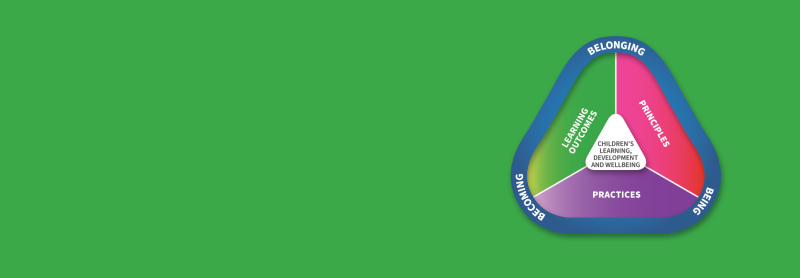- Home
- BELONGING, BEING & BECOMING - THE EARLY YEARS LEARNING FRAMEWORK
- (EYLF) LEARNING OUTCOMES
Table of contents
- BELONGING, BEING & BECOMING - THE EARLY YEARS LEARNING FRAMEWORK
- (EYLF) INTRODUCTION
- (EYLF) A VISION FOR CHILDREN'S LEARNING
- (EYLF) ELEMENTS OF THE EARLY YEARS LEARNING FRAMEWORK
- (EYLF) EARLY CHILDHOOD PEDAGOGY
- (EYLF) PRINCIPLES
- (EYLF) PRACTICES
- (EYLF) THE EARLY YEARS LEARNING FRAMEWORK PLANNING CYCLE
- (EYLF) LEARNING OUTCOMES
- (EYLF) GLOSSARY OF TERMS
- (EYLF) REFERENCES
(EYLF) LEARNING OUTCOMES

The 5 Learning Outcomes are designed to capture the integrated and complex learning and development of all children across the birth to 5 age range. The Learning Outcomes are:
- Children have a strong sense of identity
- Children are connected with and contribute to their world
- Children have a strong sense of wellbeing
- Children are confident and involved learners
- Children are effective communicators.
The Learning Outcomes are broad and observable. They acknowledge children learn in a variety of ways and vary in their capabilities and pace of learning. Over time children engage with increasingly complex ideas and learning experiences, which are transferable to other situations.
Learning in relation to the Learning Outcomes is influenced by:
- each child’s context, including previous experiences, culture, languages spoken, capabilities, emotional wellbeing, dispositions and learning preferences
- educators’ practices and the early childhood environment
- engagement with each child’s family and community
- the integration of learning across the Learning Outcomes.
Children’s learning is ongoing, and each child will progress towards the Learning Outcomes in different and equally meaningful ways. Learning is not always predictable and linear. Educators plan for each child, small and whole groups with the context and the Learning Outcomes in mind. The following Learning Outcomes demonstrate how the 4 elements of the Framework – Vision, Principles, Practices and Learning Outcomes – combine to guide curriculum decision-making and assessment to promote children’s learning.
Key components of learning in each Outcome are expanded to provide examples of evidence that educators may observe in children as they learn. Examples of practice to promote children’s learning are also included.
There will be many other ways that children demonstrate learning within and across the Learning Outcomes. Educators understand, engage with and promote children’s learning. They talk with families and communities to make locally based decisions, relevant to each child and their community.
There is provision for educators to list specific examples of evidence and practice that are culturally and contextually appropriate to each child and their settings.
The 5 Learning Outcomes are relevant for all children. The guidance provides some examples of how educators may work to promote these outcomes and how children’s learning may be evident. When using the Learning Outcomes for planning, educators can modify them to meet the requirements of learners in their learning spaces. Approved providers and educators have inclusion obligations under the Disability Discrimination Act and the Racial Discrimination Act and make reasonable adjustments for all Learning Outcomes to ensure learning engagement for all children. It is acknowledged that children come to the setting with different funds of knowledge, skills and dispositions. Very young and older children are growing, developing and learning in individual ways and may demonstrate the Learning Outcomes differently. Educators’ knowledge of individual children, their strengths and capabilities will guide professional judgement to ensure all children are engaging in a range of experiences across all the Learning Outcomes in ways that optimise their learning. They are committed to equity, inclusion and have high expectations for every child regardless of their circumstances and capabilities.